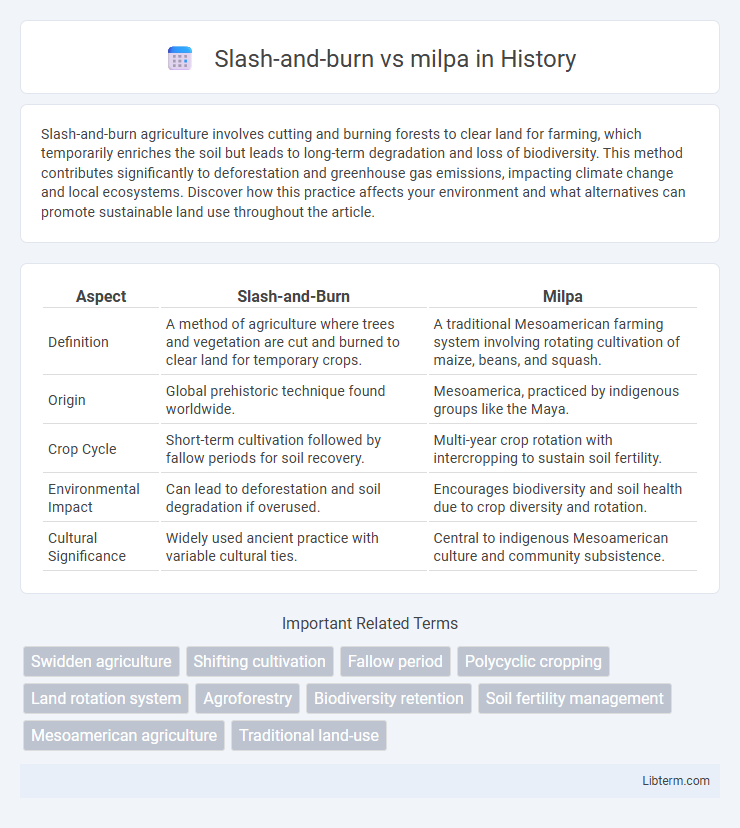Slash-and-burn agriculture involves cutting and burning forests to clear land for farming, which temporarily enriches the soil but leads to long-term degradation and loss of biodiversity. This method contributes significantly to deforestation and greenhouse gas emissions, impacting climate change and local ecosystems. Discover how this practice affects your environment and what alternatives can promote sustainable land use throughout the article.
Table of Comparison
| Aspect | Slash-and-Burn | Milpa |
|---|---|---|
| Definition | A method of agriculture where trees and vegetation are cut and burned to clear land for temporary crops. | A traditional Mesoamerican farming system involving rotating cultivation of maize, beans, and squash. |
| Origin | Global prehistoric technique found worldwide. | Mesoamerica, practiced by indigenous groups like the Maya. |
| Crop Cycle | Short-term cultivation followed by fallow periods for soil recovery. | Multi-year crop rotation with intercropping to sustain soil fertility. |
| Environmental Impact | Can lead to deforestation and soil degradation if overused. | Encourages biodiversity and soil health due to crop diversity and rotation. |
| Cultural Significance | Widely used ancient practice with variable cultural ties. | Central to indigenous Mesoamerican culture and community subsistence. |
Introduction to Slash-and-Burn and Milpa
Slash-and-burn is an agricultural technique involving the cutting and burning of vegetation to clear land for cultivation, primarily used in tropical regions to temporarily enrich soil with ash nutrients. Milpa, a traditional Mesoamerican system, integrates slash-and-burn methods to cultivate maize, beans, and squash in a sustainable cycle that supports biodiversity and soil health. Both approaches emphasize cyclical land use but differ in cultural significance and crop diversity, with milpa reflecting indigenous practices rooted in community subsistence.
Historical Origins of Slash-and-Burn
Slash-and-burn agriculture, with origins dating back over 12,000 years, emerged as an early method for clearing forests by Native peoples worldwide, enabling cultivation in nutrient-poor tropical soils. Milpa, a traditional Mesoamerican system, evolved from slash-and-burn techniques to incorporate cyclical farming of maize, beans, and squash, optimizing soil fertility and biodiversity. Understanding the historical roots of slash-and-burn highlights its role as a foundation for sustainable agroecological practices like milpa in indigenous agriculture.
The Traditional Milpa Farming System
The traditional milpa farming system integrates slash-and-burn techniques with cyclical cultivation of maize, beans, and squash to maintain soil fertility and biodiversity in Mesoamerican regions. Unlike indiscriminate slash-and-burn, milpa employs controlled burning and multi-crop planting, promoting sustainable land use and preserving ecological balance. This agroecological practice supports food security and cultural heritage by optimizing nutrient cycling and minimizing environmental degradation.
Key Differences in Land Use Practices
Slash-and-burn agriculture involves clearing forested land by cutting and burning vegetation to create temporary plots for cultivation, often leading to soil nutrient depletion and reduced fertility over time. Milpa is a traditional Mesoamerican system that integrates crop diversity, primarily maize, beans, and squash, using cyclical cultivation methods and allowing land to lie fallow for natural regeneration. Key differences include milpa's emphasis on biodiversity and sustainable land rotation versus slash-and-burn's often single-season use without planned fallow periods, impacting long-term soil health and ecosystem stability.
Environmental Impact: Slash-and-Burn vs Milpa
Slash-and-burn agriculture causes significant deforestation and soil degradation due to the complete clearing and burning of vegetation, which releases large amounts of carbon dioxide and reduces soil fertility over time. In contrast, milpa systems employ a cyclical method of crop rotation and fallow periods, promoting soil regeneration and biodiversity while minimizing long-term environmental damage. Milpa practices support sustainable land use by maintaining ecological balance and reducing carbon emissions compared to the more destructive slash-and-burn technique.
Crop Diversity and Biodiversity Outcomes
Milpa agriculture incorporates slash-and-burn techniques but emphasizes polyculture, cultivating diverse crops like maize, beans, and squash that enhance soil fertility and support a wider range of biodiversity compared to monoculture slash-and-burn systems. This crop diversity in milpa reduces pest outbreaks and promotes ecological resilience by maintaining habitats for beneficial insects and wildlife. In contrast, traditional slash-and-burn often leads to biodiversity loss due to shorter fallow periods and less varied plant species, which diminish ecosystem complexity and recovery.
Socioeconomic Factors Influencing Adoption
Socioeconomic factors such as land tenure security, labor availability, and market access significantly influence the adoption of slash-and-burn versus milpa agricultural systems. Communities with secure land rights and access to labor tend to adopt milpa due to its sustainable crop diversity and long-term soil fertility benefits. Conversely, slash-and-burn remains prevalent in regions with limited resources and urgent subsistence needs, reflecting immediate survival priorities over environmental considerations.
Sustainability and Long-term Viability
Slash-and-burn agriculture involves clearing and burning forested land, which can lead to soil degradation, reduced biodiversity, and carbon emissions, challenging long-term sustainability. In contrast, milpa farming integrates cyclical planting of maize, beans, and squash, promoting soil fertility through natural nutrient replenishment and supporting biodiversity. Milpa's polyculture system enhances resilience, making it more viable for sustainable food production over extended periods.
Modern Adaptations and Innovations
Modern adaptations of slash-and-burn agriculture integrate controlled burning techniques with agroforestry to enhance soil regeneration and reduce environmental impact. Milpa systems now incorporate improved crop varieties and sustainable soil management practices, increasing yields and supporting biodiversity. Innovations such as precision farming tools and community-based land monitoring optimize resource use and promote ecological balance within these traditional frameworks.
Future Perspectives on Agroecological Systems
Slash-and-burn agriculture, characterized by temporary clearing and burning of forest areas, faces sustainability challenges due to deforestation and soil degradation. Milpa systems, traditional Mesoamerican polycultures integrating maize, beans, and squash, promote biodiversity and soil fertility, serving as a resilient model for agroecological practices. Future perspectives prioritize milpa-inspired agroecological systems for sustainable land management, enhancing productivity while preserving ecological balance and cultural heritage.
Slash-and-burn Infographic

 libterm.com
libterm.com